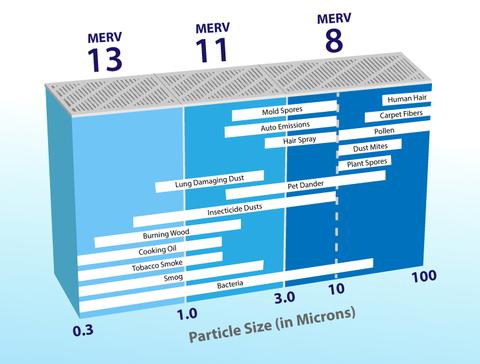Difference Between MPR and MERV Filter Ratings
January 28 2019

Difference Between MPR and MERV Filter Ratings
Quick Answer: The difference between MPR vs MERV is the fact that MPR was created by the company 3M and only 3M filters use this scale. The ratings also consider different elements. MERV effectively rates the filter’s ability to capture and filter out all pollutants and particles, whereas MPR specifically rates the filter’s ability to capture particles smaller than 1 micron.
When it comes to purchasing a new air filter, you may feel out of your depth when trying to understand the various acronyms that you’ll find within product listings. More specifically, you might find yourself caught up on what MERV and MPR really mean, and what the difference between the two is.
Simply put, the two acronyms are rating systems for the filters themselves, which categorizes what the filter blocks and how efficient it is in certain environments. MERV and MPR are two different rating systems created by different organizations that offer insight into the performance of the filter in question.
The main difference between the two is that they’re each looking at the filter’s ability to capture particles of different sizes, which means that the filter could work differently depending on the atmosphere and the particles that you want to filter out.
A filter rating will tell you how much the filter blocks and what level of pollution it can deal with, but the two different acronyms are looking at different particle sizes, which is an important thing to know before making your next filter purchase.
MERV vs MPR
MERV
Within the US, every air filter is required to carry a MERV rating that has been established by the American Society of Heating, Refrigerating, and Air Conditioning Engineers. The MERV rating, which stands for Minimum Efficiency Reporting Value, rates the system’s efficiency when it comes to capturing and filtering out all air particles and pollutants that may be found within the air environment.
MERV ratings classify filters on a scale on 1 to 20, and the higher the rating, the more particles the filter is able to capture. Generally, your furnace filter will have an optimum MERV filter rating that allows it to do its job as well as possible. This is due to the fact that, if a MERV rating is too high, it can cause your entire unit to be put under too much pressure. Therefore, it’s important to ensure you pay attention to the classification of the MERV rating of the air filter that you’re looking to buy.
MPR
Whereas MERV is a rating that can apply to all air filters, MPR is a rating that was created by the company 3M, and so it only applies to filters produced by the 3M brand. MPR stands for Microparticle Performance Rating and, as the name suggests, it rates the filter’s ability to filter out micro particles.
The MPR specifically rates the filter’s ability to capture and block particles that are smaller than 1 micron, so it doesn’t consider bigger particles that the filter may have to filter out. The MPR rating system also varies a lot more than the MERV rating system does, with the ratings ranging from 300 MPR to 2800 MPR.
The Main Difference
All in all, the key difference between the two air filter ratings is that while MERV is a national rating system and considers all sizes of air particles, MPR only considers particles smaller than 1 micron and isn’t nationally recognized. MERV ratings generally provide a wider overview of the efficiency of the air filter.
